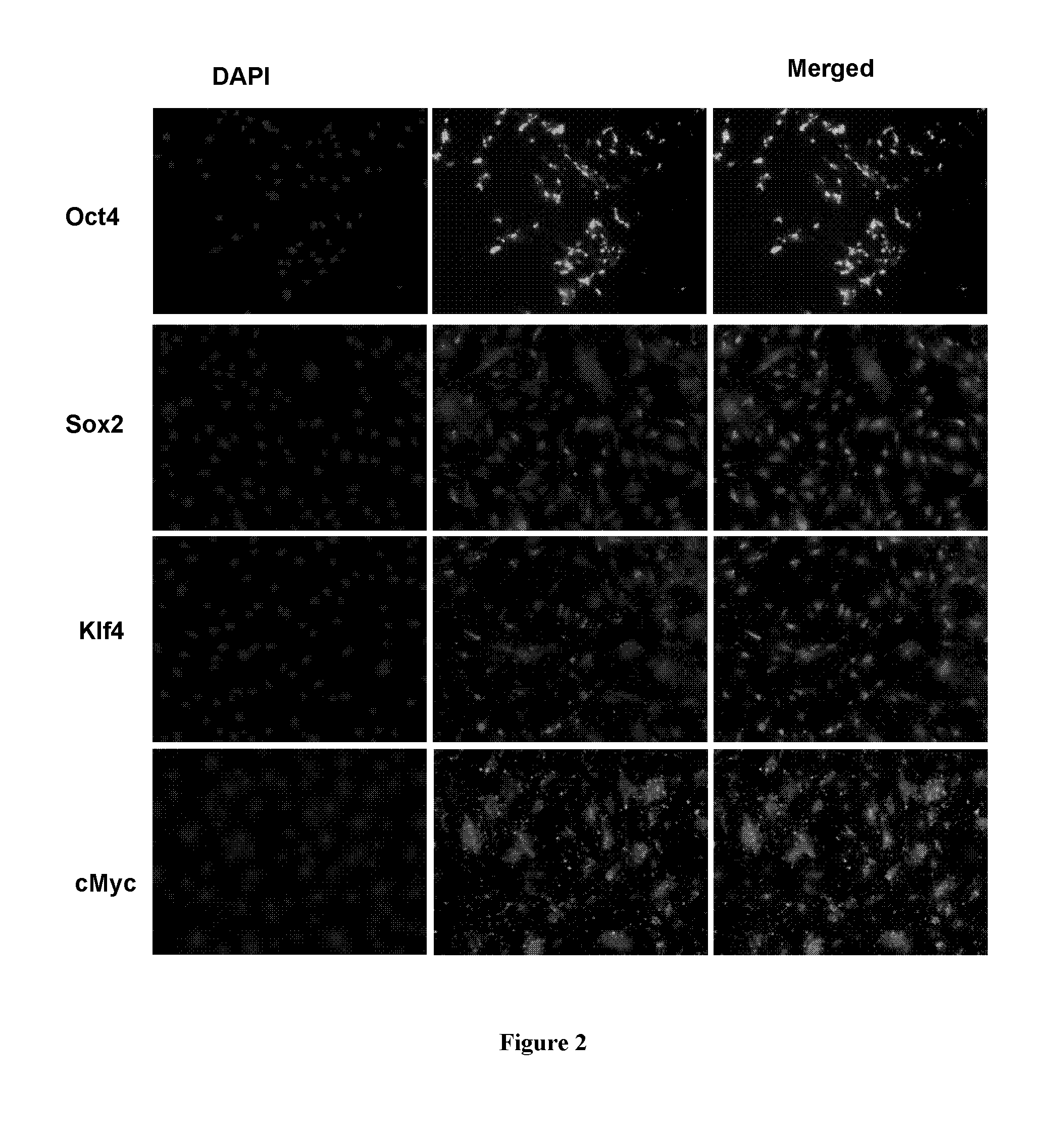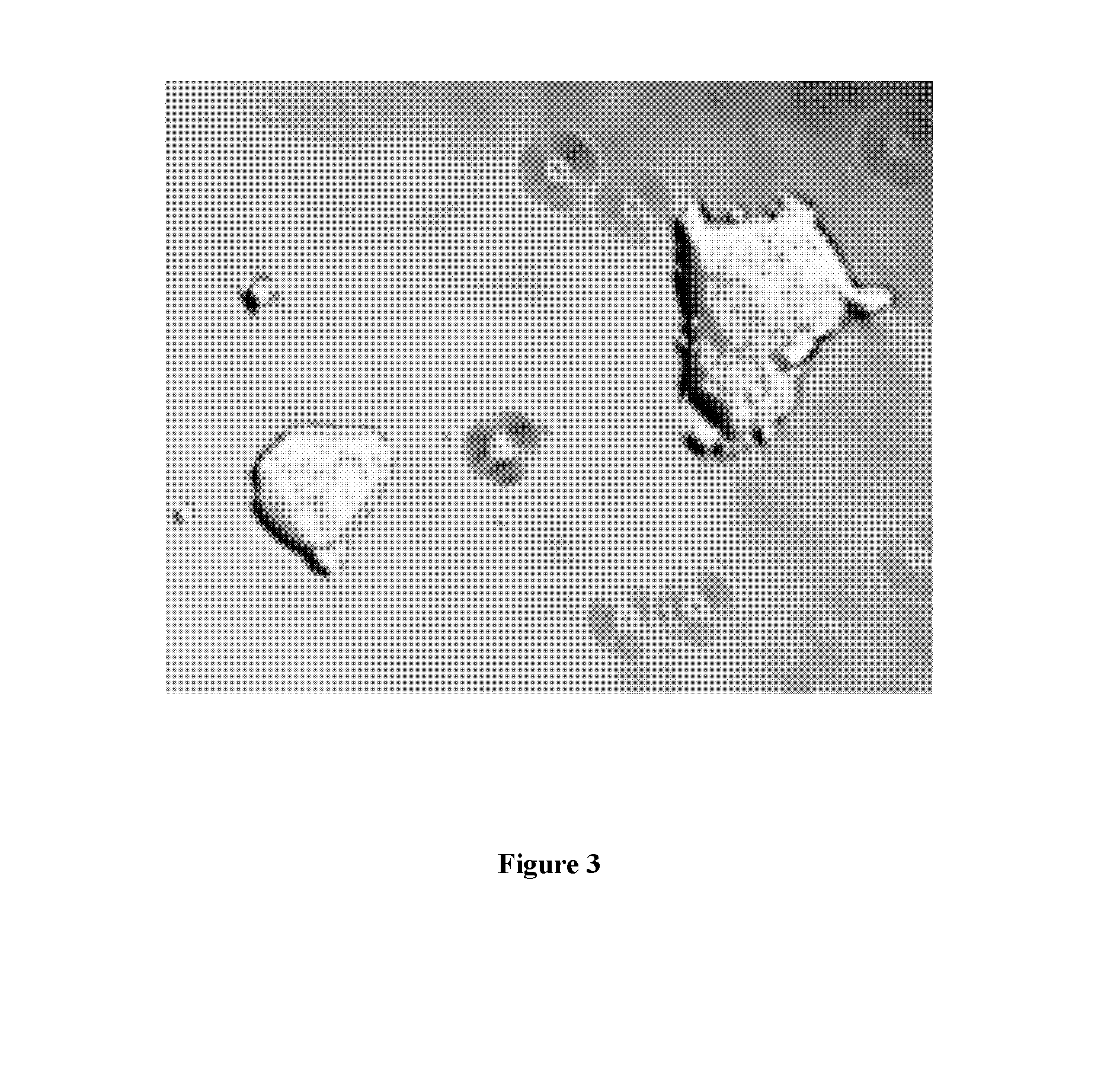Compositions and methods for re-programming cells without genetic modification for repairing cartilage damage
a technology of cartilage damage and reprogramming cells, applied in cell culture active agents, peptide/protein ingredients, unknown materials, etc., can solve the problems of limited regeneration capacity, low cell density, limited nutrient supply, and low cell density of cartilag
- Summary
- Abstract
- Description
- Claims
- Application Information
AI Technical Summary
Benefits of technology
Problems solved by technology
Method used
Image
Examples
example 1
Reprogramming Somatic Cells to Induced Pluripotent Stem Cells (iPSCs)
[0098]1.a. Preparation of transducible material Oct4-11R, Sox2-11R, Klf4-11R, and cMyc-11R.
[0099]A poly-arginine protein transduction domain was fused to the C-terminal of each reprogramming proteins Oct4, Sox2, Klf4 and cMyc through a linker SEQ ID NO. 55 to form a fused protein Oct4-11R, Sox2-11R, Klf4-11R and cMyc-11R respectively (FIG. 1A). These poly-arginine fused proteins were expressed in E. Coli in inclusion body form, which were then solubilized, refolded, and further purified to render transducible materials Oct4-11R, Sox2-11R, Klf4-11R and cMyc-11R. The protein identities were confirmed by mass spectrometry and Western blot analysis (FIG. 1B).
[0100]1.b. Cell permeability and stability of transducible material Oct4-11R, Sox2-11R, Klf4-11R, and cMyc-11R
[0101]A transducible material (Oct4-11R, Sox2-11R, Klf4-11R, or cMyc-11R) was added to mouse embryonic fibroblast (MEF) cells at various concentrations for...
example 2
[0106]Reprogramming of liver and pancreatic exocrine cells to insulin-producing beta cells by transducible materials His6-Ngn3-11R, His6-PDX1-11R and His 6-MafA-11R in mouse.
[0107]A poly-arginine protein transduction domain was fused respectively to the C-terminal of each reprogramming protein (Ngn3, PDX1 and MafA) through a linker (SEQ ID NO: 55) to form His6-Ngn3-11R, His6-PDX1-11R and His6-MafA-11R respectively (FIG. 7). His6 (SEQ ID NO: 59) was included to facilitate protein purification. These poly-arginine fused proteins were expressed in E. Coli in inclusion body form, which were then solubilized, refolded, and further purified to prepare transducible materials His 6-Ngn3-11R, His6-PDX1-11R and His6-MafA-11R. The protein identities were confirmed by mass spectrometry and Western blot analysis.
[0108]Six CD-1 mice (Charles River Laboratory) were divided into two groups: the treatment group and the control group. Transducible material His6-Ngn3-11R (1 mg / kg), His 6-PDX1-11R (1 m...
example 3
[0109]Reprogramming of T cells and programs them to Treg cells using transducible material Foxp3.
[0110]A poly-arginine protein transduction domain was fused to the C-terminal of each reprogramming protein Foxp3 through a linker (SEQ ID NO: 55) to form His6-Foxp3-11R (FIG. 7). His6 (SEQ ID NO: 59) was included to facilitate protein purification. The poly-arginine fused protein was expressed in E. Coli in inclusion body form, which were then solubilized, refolded, and further purified to prepare transducible materials His6-Foxp3-11R. The protein identities were confirmed by Western blot analysis.
[0111]100 ml of healthy human blood was collected from a donor and the peripheral blood mononuclear cells (PBMCs) were isolated by density-gradient centrifugation using Histopaque-1077 (Sigma-Aldrich, St Louis, Mo.). CD14+ monocytes were removed by magnetic bead selection (Miltenyi Biotec, Auburn, Calif.). Briefly, 108 PBMCs were incubated with 200 μL anti-CD14 microbeads (Miltenyi Biotec) in ...
PUM
| Property | Measurement | Unit |
|---|---|---|
| Fraction | aaaaa | aaaaa |
| Composition | aaaaa | aaaaa |
| Therapeutic | aaaaa | aaaaa |
Abstract
Description
Claims
Application Information
 Login to View More
Login to View More - R&D
- Intellectual Property
- Life Sciences
- Materials
- Tech Scout
- Unparalleled Data Quality
- Higher Quality Content
- 60% Fewer Hallucinations
Browse by: Latest US Patents, China's latest patents, Technical Efficacy Thesaurus, Application Domain, Technology Topic, Popular Technical Reports.
© 2025 PatSnap. All rights reserved.Legal|Privacy policy|Modern Slavery Act Transparency Statement|Sitemap|About US| Contact US: help@patsnap.com



